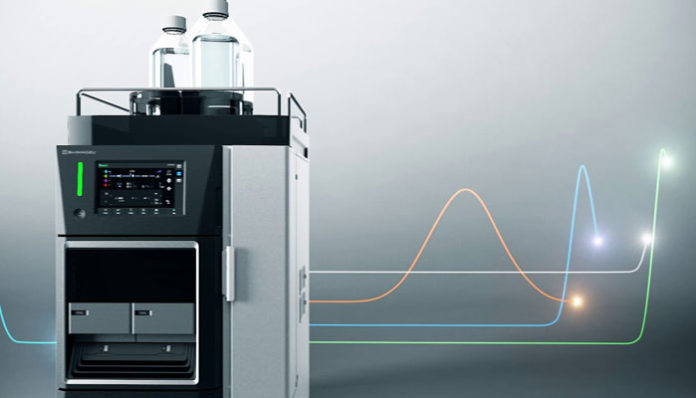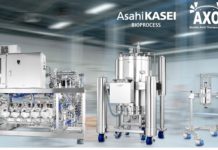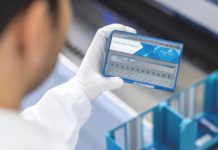Shimadzu’s new ultra-high performance liquid chromatography system is designed to solve common problems in biopharma analysis.
Shimadzu launched its new Nexera XS inert, a bioinert and biocompatible ultra-high performance liquid chromatograph (UHPLC), in July 2022. The system is designed to resolve the most common problems in biopharmaceutical analysis, such as the adsorption of target molecules to metal surfaces and mobile-phase corrosion caused by high salt content and extreme pH conditions.
The Nexera XS inert UHPLC resulted from cooperative research done with Yasushi Ishihama, a professor at the Graduate School of Pharmaceutical Sciences at Kyoto University in Japan under the Japan Science and Technology Agency’s Adaptable and Seamless Technology Transfer Program through Target-driven R&D (A-STEP) project from 2017 to 2020. The system features a metal-free sample flow path, which prevents unwanted interaction with biopolymers that are prone to adsorption onto exposed metal sites. Through this mechanism, the Nexera XS inert results in reduced sample loss and excellent peak shape for generating reproducible, high-sensitivity and high-quality reliable data, according to a July 19, 2022 company press release.
Furthermore, all wetted surfaces have been prepared from corrosion-resistant materials, which renders them stable against mobile-phase solvents that contain high concentrations of salts or acids. Nexera XS inert is particularly well-suited for analyzing biopharmaceutical molecules, such as antibodies, peptides, and nucleic acid drugs.
The new system offers the same analytical intelligence features as the other products in the Nexera series as well as the following features:
- Unconstrained recovery and sensitivity: in the quantitative analysis of biomolecules, adsorption of the target compound to a metal surface can result in a dramatic decrease in sensitivity. The Nexera XS inert system comprises stainless-steel-casing-reinforced polyether ether ketone (PEEK) tubing, which is a high-performance engineered polymer with mechanical- and chemical-resistance properties. This ensures a system pressure tolerance of > 100 MPa while maintaining a bioinert flow path. The system also includes a ceramic injection needle, which offers metal-free injections and minimized carryover. By preventing adsorption to metal surfaces, the Nexera XS inert system thus achieves much higher sensitivity and better reproducibility than a general-purpose UHPLC system.
- Assured reliability and reproducibility: high salt conditions in the mobile phase can result in the corrosion of stainless-steel parts in standard UHPLC systems, but, in the Nexera XS inert system, the wetted surfaces are prepared from highly rust-resistant materials, while still maintaining the high-efficiency flow-path (i.e., 105 MPa). Because of this design, the system remains unaffected by high salt content, ion pairing agents, or extreme pH conditions, ensuring long-term stability and reliable data acquisition.
- Clear resolution without restrictions: the system’s ability to resist 105 MPa of pressure means it can use long separation columns packed with small-sized particles, which allows it to achieve ultra-high efficiency in a wide variety of applications. The newly developed PEEK-lined tubing comes with tool-free, finger-tightened fittings, allowing for reliable connections between columns, which enables the system to withstand a pressure of up to 105 MPa without creating any dead volume or risking damage by overtightening. All valves used in the Nexera XS inert system have been designed to inhibit metal adsorption for worry-free switching between multiple columns. This characteristic is useful for method development or for trap-and-elute analysis. An optional pHM-40 offers real-time measurement of the mobile-phase pH during the course of an experiment. This ensures accuracy and traceability, even when running a pH gradient, as used in ion exchange chromatography.
- Consumables ideal for analyzing biopharmaceuticals: analyzing biomolecules, such as proteins, peptides and nucleic acids, requires columns with different separation modes. For some samples that are sensitive to metal ions, metal adsorption must be taken into consideration, and an optimal column would address this issue. The columns used in this new system (Shim-pack series of columns) is fitting for the analysis of a wide variety of biomolecules. In addition, adsorption of target analytes in the sample vial can greatly affect the analysis and requires special attention. Furthermore, a low-adsorption polypropylene vial (TORAST-H Bio Vial, Shimadzu) is also most fitting for peptide drug research, while low-adsorption glass vials (TORAST-H, Shimadzu) are suitable for general-purpose analysis.


























